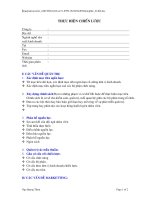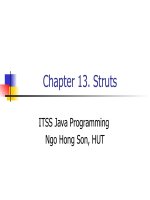C1355 c13
Bạn đang xem bản rút gọn của tài liệu. Xem và tải ngay bản đầy đủ của tài liệu tại đây (23.6 KB, 2 trang )
Designation: C 1355/C 1355M – 96
Standard Specification for
Glass Fiber Reinforced Gypsum Composites1
This standard is issued under the fixed designation C 1355/C 1355M; the number immediately following the designation indicates the
year of original adoption or, in the case of revision, the year of last revision. A number in parentheses indicates the year of last
reapproval. A superscript epsilon (e) indicates an editorial change since the last revision or reapproval.
Vertical Tube Furnace at 750°C7
1. Scope
1.1 This specification covers glass fiber reinforced gypsum
(GRG) composites having minimum properties and quality
suitable to allow the production of GRG parts for non-loading
bearing, thin section, ornamental shapes for architectural
embellishment of interior building construction.
1.2 The values stated in either inch-pound units or SI
(metric) are to be regarded separately as standard. Within the
text, the SI units are shown in brackets. The values stated in
each system shall be independent of the other. Values from the
two systems shall not be combined.
1.3 The text of this standard references footnotes which
provide explanatory material. These footnotes shall not be
considered as requirements of the standard.
3. Terminology
3.1 Definitions—Definitions of terms shall be in accordance
with Terminology C 11.
3.2 Definitions of Terms Specific to This Standard:
3.2.1 GRG composite, n—a thin section laminate made
from the combination of alpha gypsum cement, glass fiber,
additives and water.
3.2.2 GRG part, n—an individual molded component used
as architectural embellishment.
4. Materials and Manufacture
4.1 Materials:
4.1.1 Alpha Gypsum Cement—Alpha-calcium sulfate
hemihydrate-plaster which is noncombustible, has a low water
demand, neutral (pH) or low alkalinity, and a purity of not less
than 90 % by weight of CaSO4·2H2O.
4.1.2 “E” Glass Fiber—Chopped glass fiber strands or
continuous strand mats of calcia-alumina silicate glasses conforming to Specification D 578.
4.1.3 Water—Potable water.
4.1.4 Additives—In accordance with the alpha gypsum cement manufacturer’s specifications.
4.2 Manufacturer’s Certification of Raw Materials:
4.2.1 Alpha Gypsum Cement—Each lot of alpha gypsum
cement shall be certified to be in compliance with 4.1 and 5.1.
4.2.2 Glass Fiber Reinforcement—Each lot of glass fiber
reinforcement shall be certified to be in compliance with
Specification D 578.
4.3 Composite Preparation:
4.3.1 Prepare a flat, rectangular composite of sufficient size
to obtain specimens required in 5.2. The composite prepared
shall be the same formula as the intended GRG part.
2. Referenced Documents
2.1 ASTM Standards:
C 11 Terminology Relating to Gypsum and Related Building Materials and Systems2
C 472 Test Methods for Physical Testing of Gypsum, Gypsum Plasters, and Gypsum Concrete2
C 473 Test Methods for Physical Testing of Gypsum Board
Products and Gypsum Lath2
C 947 Test Method for Flexural Properties of Thin-Section
Glass Fiber Reinforced Concrete (Using Simple Beam
with Third-Point Loading)3
D 256 Test Methods for Determining the Pendulum Impact
Resistance of Specimens of Plastics4
D 578 Specification for Glass Fiber Strands5
D 696 Test Method Coefficient of Linear Thermal Expansion of Plastics Between − 30°C and 30°C4
D 2583 Test Method for Indentation Hardness of Rigid
Plastics by Means of a Barcol Impresser6
E 84 Test Method for the Surface Burning Characteristics of
Building Materials7
E 136 Test Method for the Behavior of Materials in a
5. Mechanical Properties
5.1 Neat Alpha Gypsum Cement:
5.1.1 Normal Consistency shall be not more than 30 when
tested in accordance with Test Methods C 472.
5.1.2 Compressive Strength shall be not less than 6000 psi
(41.4 MPa) when tested in accordance with Test Methods
C 472.
5.1.3 Hardness shall be not less than 33 Barcol when tested
in accordance with Test Method D 2583.
5.2 Composite:
5.2.1 Specimen Preparation
1
This specification is under the jurisdiction of ASTM Committee C-11 on
Gypsum and Related Building Materials and Systems and is the direct responsibility
of Subcommittee C11.01 on Specifications and Test Methods for Gypsum Products.
Current edition approved Nov. 10, 1996. Published January 1997.
2
Annual Book of ASTM Standards, Vol 04.01.
3
Annual Book of ASTM Standards, Vol 04.05.
4
Annual Book of ASTM Standards, Vol 08.01.
5
Annual Book of ASTM Standards, Vol 07.01.
6
Annual Book of ASTM Standards, Vol 08.02.
7
Annual Book of ASTM Standards, Vol 04.07.
Copyright © ASTM, 100 Barr Harbor Drive, West Conshohocken, PA 19428-2959, United States.
1
C 1355/C 1355M
showing compliance with Section 5 are permitted to be
supplied by the producer showing compliance with the specified requirements.
5.2.1.1 Flexural Strength—Average Flexural Yield (FY)
shall be not less than 1200 psi (8.3 MPa) and an average
Flexural Ultimate (FU) shall be not less than 2500 psi (17.2
MPa) when tested in accordance with Test Method C 947,
using a crosshead speed of 0.08 in./min (2 mm/min). Specimens shall be conditioned to a constant weight in accordance
with Test Methods C 473.
5.2.1.2 Impact Resistance—Average impact resistance shall
be not less than 3 ft-lb (4 j) when tested in accordance with Test
Methods D 256, Test Method A (Izod-unnotched method).
5.2.1.3 Hardness—Average hardness shall be not less than
50 Barcol when tested in accordance with Test Methods
D 2583. Specimens shall be conditioned according to Test
Methods C 473.
5.2.1.4 Coeffıcient of Linear Thermal Expansion—
Coefficient of linear thermal expansion shall be not more than
11.1 3 10−6 in./in.°F (20.0 3 10−6 mm/mm°C) when tested in
accordance with Test Method D 696.
5.2.1.5 Humidified Deflection—Average humidified deflection shall be not more than 1⁄8 in. (3 mm) when tested on a 3⁄16
in. specimen (5 mm) in accordance with Test Methods C 473.
5.2.1.6 Surface Burning Characteristics—Flame spread index shall be 0 and smoke developed index shall be less than 10
when tested in accordance with Test Method E 84.
5.2.1.7 Behavior at 750°C—Shall pass all criteria when
tested in accordance with Test Method E 136.
5.2.1.8 Nail Pull Resistance—Shall be not less than 110 lbf
(489 N) when tested on a 3⁄16 in. specimen (5 mm) in
accordance with Test Methods C 473 (Method B).
8. Inspection
8.1 Inspection of the GRG composite shall be agreed upon
between the purchaser and the producer or the supplier as part
of the purchase agreement.
9. Rejection and Rehearing
9.1 GRG composite that fails to conform to the requirements of this specification shall be reported to the producer or
the supplier promptly and in writing. In case of dissatisfaction
with the results of the test, the producer or supplier, shall be
permitted to make a claim for a hearing to retest.
10. Certification
10.1 When specified in the purchase agreement, a producer’s or supplier’s report certifying that the GRG composite is in
compliance with this specification, shall be furnished at the
time of shipment.
11. Quality Assurance
11.1 Testing for compliance with this specification is required whenever glass fiber reinforced gypsum formulae are
initially established.
11.2 Additional testing for compliance with this specification is required whenever constituent materials are added or
deleted.
11.3 Each producer’s test specimens shall be representative
of actual production procedures and materials.
6. Samples Taken at the Point of Manufacture
6.1 When specified by the purchase agreement, samples of
the GRG composite shall be taken at the place of manufacture
and tested for compliance with 5.2.
12. Keywords
7. Number of Tests and Retests
7.1 The number of tests and type of tests to be performed
shall be part of the purchase agreement. Data from prior tests
12.1 alpha gypsum cement; glass fiber reinforced gypsum;
glass fiber reinforced gypsum composite; GRG; GRG composite
The American Society for Testing and Materials takes no position respecting the validity of any patent rights asserted in connection
with any item mentioned in this standard. Users of this standard are expressly advised that determination of the validity of any such
patent rights, and the risk of infringement of such rights, are entirely their own responsibility.
This standard is subject to revision at any time by the responsible technical committee and must be reviewed every five years and
if not revised, either reapproved or withdrawn. Your comments are invited either for revision of this standard or for additional standards
and should be addressed to ASTM Headquarters. Your comments will receive careful consideration at a meeting of the responsible
technical committee, which you may attend. If you feel that your comments have not received a fair hearing you should make your
views known to the ASTM Committee on Standards, at the address shown below.
This standard is copyrighted by ASTM, 100 Barr Harbor Drive, PO Box C700, West Conshohocken, PA 19428-2959, United States.
Individual reprints (single or multiple copies) of this standard may be obtained by contacting ASTM at the above address or at
610-832-9585 (phone), 610-832-9555 (fax), or (e-mail); or through the ASTM website (www.astm.org).
2









